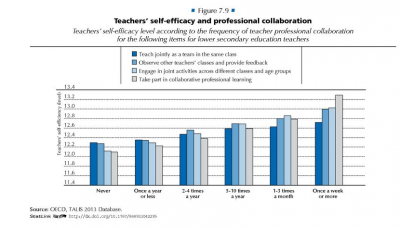Teachers who say they get included in school decision-making and collaborate often with other teachers are more likely to say that teaching is a valued profession in their society. In turn, these same teachers report higher levels of job satisfaction and confidence in their ability to teach and to motivate students, according to a 2013 survey of middle-school teachers in 34 countries and regions around the world conducted by the Organization for Economic Co-operation and Development (OECD) and published on June 25, 2014.

This article also appeared here.
The TALIS survey included class sizes, but OECD analysts found no correlation between class size and job satisfaction. Indeed, some of the higher performing nations with the highest teacher job satisfaction rates have some of the larger class sizes. The TALIS report found that the size of a random class in the United States was 27 students, compared with 36 in Singapore and 32 in Korea.
More important to teacher satisfaction than class size is the type of student in his classroom. The more behavioral problems and low-peforming students in the class, the more unhappy a teacher was. But the OECD also said these negative effects were mitigated in schools that had a supportive, collaborative atmosphere to help teachers handle behavioral disruptions. Interestingly, analysts also found no correlation between class size and behavioral disruptions. In other words, larger classes were not necessarily more difficult.
Whether teachers who feel valued by society actually teach better is unclear from the survey. But Belanger argues that it’s still important for teachers to feel that their profession is valued. “There’s a bigger picture,” she said. “With TALIS, what we’re trying to do is develop teaching as an attractive profession. If teaching is valued, it’s easier to recruit top candidates into the profession.”
This second TALIS survey was the first year that the United States participated in the OECD teacher survey. For a more detailed report of American teachers, click here.
*The top 10 in math on the most recent PISA test were (1) Shanghai, (2) Singapore, (3) Hong Kong, (4) Taipei, (5) Korea, (6) Macao, (7) Japan, (8) Lichtenstein, (9) Switzerland and (10) the Netherlands. In reading, they were (1) Shanghai, (2) Hong Kong, (3) Singapore, (4) Japan, (5) Korea, (6) Finland, (7) Canada, Ireland, Taipei and (10) Poland. (Canada, Ireland and Taipei had identical scores.)
Related Stories:
PISA math score debate among education experts centers on poverty and teaching
Top US students lag far behind top students around the world in 2012 PISA test results
Top US students decline, bottom students improve on international PISA math test




